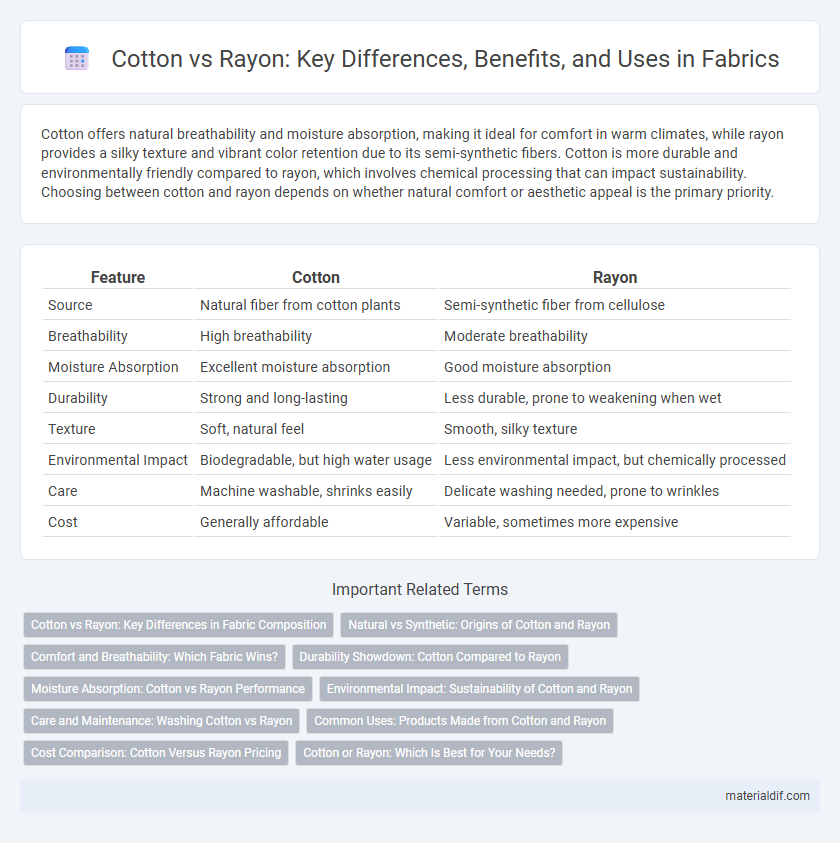Cotton offers natural breathability and moisture absorption, making it ideal for comfort in warm climates, while rayon provides a silky texture and vibrant color retention due to its semi-synthetic fibers. Cotton is more durable and environmentally friendly compared to rayon, which involves chemical processing that can impact sustainability. Choosing between cotton and rayon depends on whether natural comfort or aesthetic appeal is the primary priority.
Table of Comparison
| Feature | Cotton | Rayon |
|---|---|---|
| Source | Natural fiber from cotton plants | Semi-synthetic fiber from cellulose |
| Breathability | High breathability | Moderate breathability |
| Moisture Absorption | Excellent moisture absorption | Good moisture absorption |
| Durability | Strong and long-lasting | Less durable, prone to weakening when wet |
| Texture | Soft, natural feel | Smooth, silky texture |
| Environmental Impact | Biodegradable, but high water usage | Less environmental impact, but chemically processed |
| Care | Machine washable, shrinks easily | Delicate washing needed, prone to wrinkles |
| Cost | Generally affordable | Variable, sometimes more expensive |
Cotton vs Rayon: Key Differences in Fabric Composition
Cotton is a natural fiber harvested from the cotton plant, known for its breathability, softness, and moisture absorption, making it ideal for comfortable clothing. Rayon, on the other hand, is a semi-synthetic fiber derived from cellulose found in wood pulp, offering a silky texture and excellent drape but less durability compared to cotton. The key differences in fabric composition reveal cotton's natural origin and hypoallergenic properties, whereas rayon undergoes chemical processing that affects its strength and environmental impact.
Natural vs Synthetic: Origins of Cotton and Rayon
Cotton is a natural fiber harvested from the seed hairs of the cotton plant, known for its breathability, softness, and biodegradability. Rayon, on the other hand, is a semi-synthetic fiber derived from regenerated cellulose, typically sourced from wood pulp, combining natural raw materials with chemical processing. The key difference lies in cotton's direct plant origin versus rayon's transformation through chemical treatments, impacting their environmental footprint and fabric properties.
Comfort and Breathability: Which Fabric Wins?
Cotton excels in comfort and breathability due to its natural fibers that allow superior air circulation and moisture absorption, making it ideal for warm climates and sensitive skin. Rayon, a semi-synthetic fiber, offers a silky texture and moderate breathability but tends to retain more moisture, which can reduce overall comfort in hot or humid conditions. For optimal comfort and breathability, cotton is the preferred choice in apparel and home textiles.
Durability Showdown: Cotton Compared to Rayon
Cotton fibers exhibit superior durability compared to rayon due to their natural strength and resistance to wear and tear. Rayon, although softer and more absorbent, tends to weaken when exposed to moisture and repeated washing, leading to quicker degradation. The inherent resilience of cotton makes it a preferred choice for long-lasting textiles requiring frequent laundering.
Moisture Absorption: Cotton vs Rayon Performance
Cotton excels in moisture absorption, capable of absorbing up to 27 times its weight in water, making it highly breathable and comfortable for hot, humid conditions. Rayon, while derived from cellulose like cotton, absorbs moisture more quickly but tends to retain it, causing slower drying times and reduced breathability. This difference significantly impacts fabric performance, with cotton favored for moisture management and rayon preferred for its smooth, silky texture despite lower moisture-wicking capabilities.
Environmental Impact: Sustainability of Cotton and Rayon
Cotton, a natural fiber, generally has a lower environmental impact in terms of biodegradability compared to rayon, which is semi-synthetic and often involves chemical-intensive production processes. However, conventional cotton cultivation requires significant water, pesticides, and land resources, raising concerns about sustainability, whereas sustainably sourced rayon, such as lyocell, uses closed-loop production methods that recycle solvents and reduce pollution. Choosing organic cotton or certified sustainable rayon can mitigate environmental harm and promote eco-friendly textile options.
Care and Maintenance: Washing Cotton vs Rayon
Cotton fabrics can withstand higher washing temperatures and frequent laundering without significant wear, making them easier to maintain with machine washing and tumble drying. Rayon requires gentle care, such as hand washing or using a delicate cycle with cold water, and air drying to prevent shrinking and fabric damage. Proper care ensures cotton's durability, while rayon's delicate nature demands more careful handling to maintain softness and longevity.
Common Uses: Products Made from Cotton and Rayon
Cotton is widely used in clothing such as t-shirts, jeans, underwear, and bed linens due to its breathability and softness. Rayon, a semi-synthetic fiber, is popular for flowing dresses, blouses, and linings because of its smooth texture and ability to mimic silk. Both fibers appear in home textiles, but cotton dominates towels and sheets while rayon is favored in decorative fabrics and upholstery.
Cost Comparison: Cotton Versus Rayon Pricing
Cotton generally costs more than rayon due to its natural fiber status and labor-intensive cultivation process, which increases raw material expenses. Rayon, a semi-synthetic fiber made from cellulose, is more affordable because it can be mass-produced with lower production costs and less reliance on agricultural conditions. Pricing variations also depend on fabric quality, production scale, and regional manufacturing practices.
Cotton or Rayon: Which Is Best for Your Needs?
Cotton offers superior breathability and natural moisture absorption, making it ideal for sensitive skin and warmer climates, while rayon provides a smooth, silk-like texture with excellent drape and vibrant color retention, suitable for fashion-forward apparel. Cotton is biodegradable and hypoallergenic, enhancing its appeal for eco-conscious consumers, whereas rayon, though semi-synthetic, offers versatility through its blend of natural cellulose and chemical processing. Choosing between cotton and rayon depends on priorities such as comfort, durability, sustainability, and fabric care requirements tailored to personal or environmental needs.
Cotton vs Rayon Infographic

 materialdif.com
materialdif.com